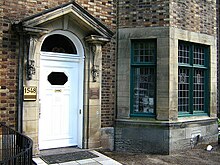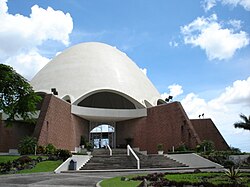Baháʼí Faith in North America
The sixth of the tablets was the first to mention Latin American regions and was written on 8 April 1916, but was delayed in being presented in the United States until 1919—after the end of the First World War and the Spanish flu pandemic.The sixth tablet was translated and presented by Mirza Ahmad Sohrab on 4 April 1919, and published in Star of the West magazine on 12 December 1919.[5] The Baháʼí National Spiritual Assembly of the United States and Canada appointed the Inter-America Committee to take charge of the preparations.[7] In 1946, a great pioneer movement, the Ten Year Crusade, began with, for example, sixty percent of the British Baháʼí community eventually relocating.[8] As far back as 1951 the Baháʼís had organized a regional National Assembly for the combination of Mexico, Central America and the Antilles islands.The first North American woman to declare herself a Baháʼí was Mrs. Kate C. Ives, of Canadian ancestry, though not living in Canada at the time.In 1948, having grown in membership and diversity, the Bahá’í Community of Canada formed its individual National Spiritual Assembly.In a June 1953 letter, Shoghi Effendi wrote that the house "should be viewed in the nature of a national Shrine, because of its association with the beloved Master, during His visit to Montreal.[22] The American Religious Identity Survey (ARIS) conducted in 2001, with a sample size of 50,000, estimated that there were 84,000 self-identifying adult (21 and over) Baháʼís in the United States.[23] The Association of Religion Data Archives estimated there were some 525,000 Baháʼís in 2005[16] however statistics in Feb 2011 show 175,000[24] excluding Alaska and Hawai'i.[29] Baháʼís sources as of 2009 the national community includes various peoples and tribes of over 4,000 members organized in groups in over 30 locations throughout the country.[16] The history of the Baháʼí Faith in Panama begins with a mention by ʻAbdu'l-Bahá in the book Tablets of the Divine Plan, published in 1919; the same year, Martha Root made a trip around South America and included Panama on the return leg of the trip up the west coast.In 1983 Bill Nedden is credited with being the first pioneer to Dominica at the festivities associated with the inaugural election of the Dominican Baháʼís National Spiritual Assembly[43] with Hand of the Cause, Dhikru'llah Khadem representing the Universal House of Justice.[51] Public recognition of the religion came in the form of the Governor General of Jamaica, Sir Howard Cooke, proclaiming a National Baha'i Day first on 25 July in 2003 and it has been an annual event since.


Baháʼí FaithBaháʼu'lláhThe BábʻAbdu'l-BaháTeachingsUnity of GodUnity of humanityUnity of religionPrayerCalendarNineteen Day FeastKitáb-i-AqdasKitáb-i-ÍqánThe Hidden WordsSome Answered QuestionsOther TextsCovenant of Baháʼu'lláhAdministrative OrderThe GuardianshipUniversal House of JusticeSpiritual AssembliesBaháʼí historyTimelineBábismPersecutionShoghi EffendiHands of the CauseApostlesOther BaháʼísBábisLetters of the LivingMullá HusaynTáhirihHouse of WorshipShrine of Baháʼu'lláhQiblihShrine of the BábSíyáh-ChálWorld CentrePilgrimageSocioeconomic developmentProgressive revelationCosmologySymbolsHomosexualityGenderSciencePropheciesStatisticsOrthographyBaháʼí House of Worship in Wilmette, IllinoisUnited StatesCanadaBaháʼí Houses of WorshipWilmette, IllinoisPanama CityPanamatabletsTablets of the Divine PlanLatin AmericanFirst World WarSpanish fluMexicoSouth AmericaMartha RootMirza Ahmad SohrabStar of the WestKingdom of GodPuerto RicoJamaicaLesser AntillesBahama IslandsWatling IslandLeonora ArmstrongpioneersNational Spiritual AssemblyBaháʼí House of WorshipLocal Spiritual AssembliespioneerTen Year CrusadeLeewardWindwardVirgin IslandsCharlotte AmalieHand of the CauseRúhíyyih KhánumWilliam MaxwellCanada 2011 CensusSpiritual Assemblyprovinces and territories of Canadaof indigenous peoplesMoojan MomenStatistics CanadaAssociation of Religion Data ArchivesWorld Christian EncyclopediaBaháʼí House of Worship, in IllinoisOttawaMontrealjourneys to the WestBaháʼí Faith in the United StatesThornton ChaseAmerican Religious Identity SurveySouth CarolinaBaháʼí Faith in fictionBaháʼí Faith in MexicoLocal Spiritual AssemblyReligion in BelizeBaháʼí Faith in Costa RicaSan JoséBaháʼí Faith in PanamaPanama City, PanamaSan MiguelitoChiriquíBaháʼí Faith in BarbadosʻAlí-Muhammad VarqáBaháʼí Faith in DominicaDhikru'llah KhademBaháʼí Faith in HaitiLouis George GregoryPort-au-PrinceBaháʼí Faith in JamaicaGreater AntillesHoward CookeBaháʼí Faith in Trinidad and TobagoCaribbeanBaháʼí Faith and Native Americans